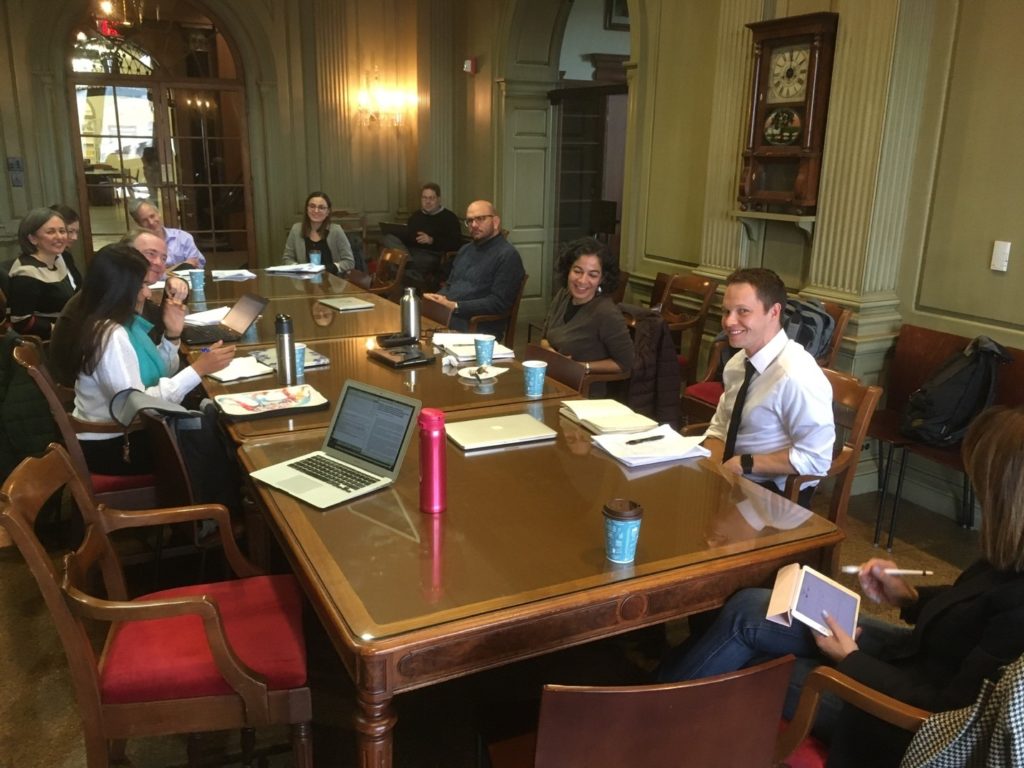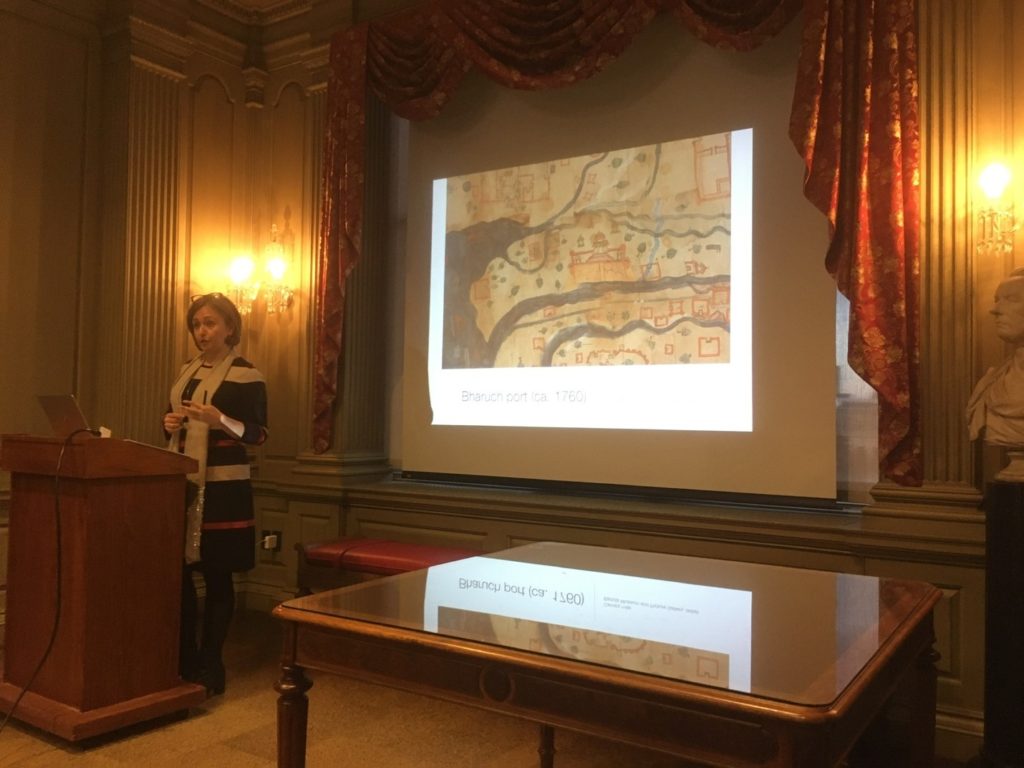
By Weijia Vicky Shen, University of Pittsburgh
On November 8, 2019, I attended the “Rethinking India’s Eighteenth Century” workshop at the University of Pittsburgh. The day-long gathering began with me sitting uncomfortably at a round table in the Humanities Center, surrounded by established scholars of South Asia. My anxiety stemmed in part from being the only graduate student there, but was mostly due to the fact that I do not study South Asia, or the 18th century for that matter—my training is in 20th century Japan, and my knowledge about South Asia was informed primarily by the workshop papers. I was there because, like many historians of Japan, I am drawn to discussions of modernity. In the field of Japanese studies, questions surrounding alternative modernities appear to have survived protracted disputes, remaining a pertinent topic of inquiry in even the most recent scholarship.
When James Pickett invited me to participate in the workshop, I had just read To Stand with the Nations of the World: Japan’s Meiji Restoration in World History, and Mark Ravina’s rejection of the “modernization” argument was still fresh in my mind. Instead of seeing the 1868 Meiji Restoration as the beginning of Japan’s modern era, Ravina interprets the Restoration as the recapitulation of ancient policies by the new Meiji regime in response to the changing global order in East Asia, just as leaders of Japan had done in the sixth and seventh centuries in response to the rise of Sui and Tang China. To see the Meiji Restoration as mere “modernization,” argues Ravina, misses the structural continuities in the longue durée of Japanese political history. Curious to learn about discussions of South Asia’s transition into the modern era, I embarked on a journey into the late Mughal world, a field in which political modernity connotes something quite different.
As part of an ongoing process to reconcile earlier historiographies on the late Mughal world with the more abundant scholarship on the colonial period, the workshop reexamined India’s long eighteen century (c. 1680 -1815). This was a period of rapid transformation that witnessed the fragmentation of the Mughal empire and the emergence of British East India Company, and the workshop participants engaged with issues of identity, political ethics, notions of sovereignty and statehood and their relationship with capital, as well as forms of social intimacy and loyalty. In a synthesis of previously isolated historiographies, the workship papers brought together the theoretical frameworks of the so-called “Cambridge School” (known for its emphasis on imperial continuities between the East India Company and the Mughal court), the nuanced understanding of colonial sources offered by Subaltern studies, and expertise in indigenous languages sources characteristic of scholarship of the Mughal Empire, thereby offering new approaches to older questions.
Beginning with Neelam Khoja’s paper, we dove into three different narratives on the Rohillas Afghan polity, all written between 1776 and 1788, under the authorization of the East India Company. A historian of the trans-national and trans-imperial history of the Persianate zone, Khoja contextualized these narratives and proposed an alternative language, genealogical affiliation, as a replacement for “tribe” in describing Afghan political loyalty and identity. Adding to this intricate notion of political communities was Mana Kia, whose paper illuminated the critical role of intimate social bonds and companionship in Persianate politics. Through a new interpretation of Ghulam Husain Kham Tabataba’i’s much-debated history Siyar, Kia highlighted the interconnectedness between intimate relationships in the discussions of service and hierarchy, revealing the process by which customary social practices critical in Persian politics were relegated into the realm of the private and inconsequential as European discourses of rationality and legal and bureaucratic forms of justice were adopted in South Asia.
Taken together, Kia and Khoja point to the limitations of Eurocentric conceptual frameworks, hinting at the need for alternative theories and methodologies in approaching non-European history—a timely reminder of Linda Tuhiwai Smith’s Decolonizing Methodologies. In an analysis of the historical and philosophical foundations of Western academic research, Smith points to the intersections of imperialism and the discovery of knowledge. Instead of fitting indigenous knowledge into European conceptual models, which have dismissed and rejected other forms of cultural structures, as Kia’s and Khoja’s studies demonstrated, Smith proposes a critical theory that incorporates alternative epistemologies of indigenous peoples that understand forms of knowledge in their own terms.
Following Kia, Robert Travers situated the same source, the Siyar, in the context of Tabataba’i’s personal career. Building on Kumkum Chatterjee’s understanding of history writing by Mughal elites as political “self-representation,” Travers suggested the Siyar be read as a form of a petition to the East India Company government by the historian to reinforce his family status and wealth, as Tabataba’i instructed the British rulers in Mughal practices of doing justice in his account. Furthering this discussion on notions of political sovereignty, Nick Abbott traced the shifting languages of statehood and sovereignty in late Mughal India and delineated the intricacies of state formation at the imperial and provincial levels in the process of household building between rivalries. Rather than pitting these regional regimes against the imperial court, Abbott contended, the overlapping concept of the saltanat and the sarkar allowed provincial governors to oversee their own “state” formation, often justified by multiple visions of the saltanat.

Last but not least, Samira Sheikh presented a captivating cartographic history of Gujarat to demonstrate the transitions between what she termed the four linguistic registers: the imperial cosmopolitan, the local vernacular, the colonial vernacular, and the colonial cosmopolitan. The shifts in linguistic and cartographic conventions, as indicated by her illustrative sources, reflected the hybridity of different language registers and the new utilitarian role of cartography to serve the needs of emergent governmentality in South Asia. Tracing these changes and continuities in maps as well as a field book across the long 18th century, Sheikh’s terminology and attentiveness to the intersections between the imperial, local, and colonial provided an instructive framework to approach the transitional period of India’s long 18th century. The use of cartography in highlighting the role and experience of the local in the transition from early modernity to the modern era shares striking parallels with Kären Wigen’s study of Nagano Prefecture, in which she identified the continuities between what Sheikh might call a local vernacular, and a modernized, Japanese cosmopolitanism.
To an extent, all the papers above speak to the layeredness of social and political power that had been overlooked by the dichotomy of the “colonized” and the “colonizer,” a narrative that continues to be championed in national histories today. That said, if I went into the workshop content with the current discussions on modernity in Japan, I might have left with more doubts and questions. If scholars like Ravina and Wigen have reinterpreted Japan’s transition into the modern era by examining the negotiations between forms of social and political powers between the local, national, and global, what about alternative experiences of modernity within Japan—especially those at the margins of the Japanese nation state, such as Hokkaido and the Ryukyu Islands?
In the process of writing this post, I went back to Brett L. Walker’s The Conquest of Ainu Lands, where he argues that early modernity had ended in Hokkaido around 1800, when the shogun established the Hakodate magistracy and took over control of Ezo from the Matsumae domain. As someone who studies Okinawa, a region with a complex history of colonialism similar to that of Ezo, it seems that these border regions of the Japanese empire, having been incorporated into the Japanese nation state, may have had a much more complicated experience of this transitional period—something I have not thought about until the workshop. With these new insights from South Asian studies, I cannot help but wonder what a study of modernity in Japan from the perspective of the Ryukyu Islands may reveal.
If I walked into the workshop uncertain and doubtful that I would understand much, I certainly left with more assurance and confidence. Engaging with similar discussions and debates in South Asian Studies helped me identify common trends and questions pertinent to the study of Asia as a whole—and for a moment, to step out of East Asia and Japan and reexamine the field from without. As daunting as the process may have been, learning about a new field from scholars who are at its frontiers proved to be a surprisingly intellectually stimulating experience, and in this case, it certainly pointed me to the boundaries of my own academic purview.

